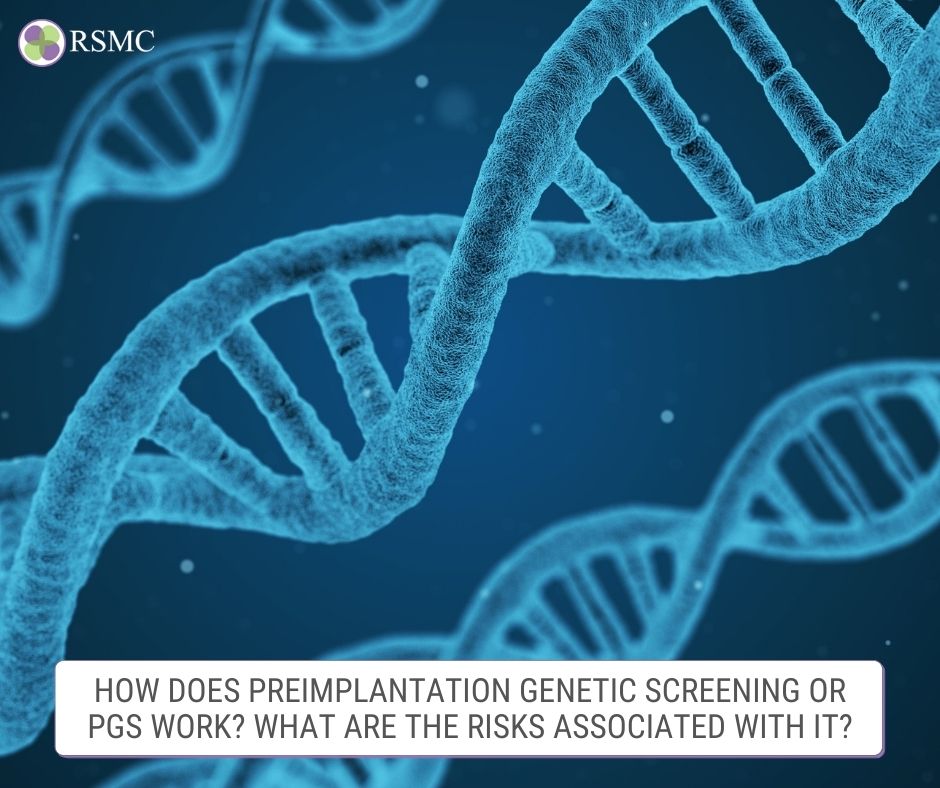Your fertility center can help in your baby’s gender selection through PGS/PGD
If you need to select the gender of your child, either for medical reasons or family balancing, your fertility center can help through a process called Preimplantation Genetic Screening (PGS) and/or Preimplantation Genetic Diagnosis (PGD).
There are a number of reasons that parents would want to determine the sex of their child, these include:
- balancing the family
- carrying on the family name
- avoiding sex-linked genetic diseases or
- allowing the parents the experience of raising a child of the selected sex.
When you’re conceiving a child the “fun” way you don’t have any real control over the sex of the child. It’s literally a 50/50 proposition. Of course, there are a lot of “methods” of gender selection you can try at home, including timing intercourse, eating more or less of certain foods, and limiting yourselves to certain sexual positions. There are always going to be people who swear by these methods, especially the methods that worked for them, but none of those methods are guaranteed.
What happens if you try one or more of the home methods of gender selection and it just doesn’t work for you but you really want to select the sex of your next child? A lot of people are starting families later, and having smaller families, so they don’t always have time to “keep trying” until they get the child of the gender they desire.
What is PGS and PGD and how do they work?
Preimplantation Genetic Screening (PGS) and Preimplantation Genetic Diagnosis (PGD), are used during IVF, they are procedures designed to examine your embryos for chromosomal abnormalities. While the embryos are being examined for chromosomal abnormalities the sex is also determined.
Screening for healthy embryos increases the pregnancy success rate because only embryos with an excellent chance of surviving are implanted. The accuracy of this procedure is 99.9%.
At most fertility centers the majority of IVF clients have a PGS screening done on their embryos before they are implanted because embryos that pass the screening have a better chance of implanting properly and developing to term. It only makes sense that, if you’re going through the time and expense to achieve a pregnancy through IVF, you would want to go through any extra steps available to increase your chances of a positive outcome.
How is gender selection accomplished through PGS?
In order to obtain an embryo for screening the Intended Parents have to undergo IVF, where the eggs retrieved from the mother are fertilized with the father’s sperm resulting in embryos that are available for testing. The embryo biopsy is taken either at day 3 or day 5 to examine all 24 chromosomes—the 22 non-sex chromosomes plus the two sex chromosomes (X & Y) in time for the embryo transfer.
PGS and PGD will also identify the gender of the embryo if you are concerned with gender-based hereditary diseases or looking for “family balancing” options. While there are differences in the two procedures, both procedures enable parents to select the gender of the embryo.
The procedure you would use depends on what information is being tested for:
- Preimplantation Genetic Screening (PGS) – is the proper term for testing for overall chromosomal normalcy in embryos. PGS is not looking for a specific disease diagnosis – it is screening the embryo for normal chromosome numbers.
- Preimplantation genetic diagnosis (PGD) – involves removing a cell from an IVF embryo to test it for a specific genetic condition (cystic fibrosis, for example) before transferring the embryo to the uterus.
There are a number of reasons to consider PGS or PGD treatment, these include:
- Patients that are having IVF with advanced female age – 38 or older
- Patients of any age with repeated IVF failure – usually defined as 3 or more failed attempts
- Patients wishing to screen for inherited genetic diseases
- Patients wishing to screen for sex-linked diseases such as hemophilia
- Patients that are carriers of chromosomal translocations
- Patients that have had recurrent miscarriages
- Patients in need of human leukocyte antigen (HLA) testing
- Intended parents who wish to select their child’s gender
Is PGS and PGD legal for gender selection in the United States?
Yes, it is. In the United States, there are no restrictions on using PGS or PGD for gender selection like there are in most parts of Europe and some other countries. Most people assume, when you’re talking about gender selection, that people want boys. While this is true in some countries, China and India in particular, it isn’t universally true.
Adoption professionals will tell you that people who want to become parents through adoption ask specifically for girls at a much higher rate than for boys. Apparently, there isn’t a universal desire for boys after all. What fertility centers are reporting is that:
- Canadians are primarily seeking girls.
- American demand is 50/50.
- German demand is 50/50.
- Asians and Indians overwhelmingly want boys.
Thanks to PGS and PGD, your fertility center can now help build the family of your dreams, right down to the gender selection of the children in it.
Your fertility center can help in your baby’s gender selection through PGS/PGD
If you need to select the gender of your child, either for medical reasons or family balancing, your fertility center can help through a process called Preimplantation Genetic Screening (PGS) and/or Preimplantation Genetic Diagnosis (PGD).
There are a number of reasons that parents would want to determine the sex of their child, these include:
- balancing the family
- carrying on the family name
- avoiding sex-linked genetic diseases or
- allowing the parents the experience of raising a child of the selected sex.
When you’re conceiving a child the “fun” way you don’t have any real control over the sex of the child. It’s literally a 50/50 proposition. Of course, there are a lot of “methods” of gender selection you can try at home, including timing intercourse, eating more or less of certain foods, and limiting yourselves to certain sexual positions. There are always going to be people who swear by these methods, especially the methods that worked for them, but none of those methods are guaranteed.
What happens if you try one or more of the home methods of gender selection and it just doesn’t work for you but you really want to select the sex of your next child? A lot of people are starting families later, and having smaller families, so they don’t always have time to “keep trying” until they get the child of the gender they desire.
What is PGS and PGD and how do they work?
Preimplantation Genetic Screening (PGS) and Preimplantation Genetic Diagnosis (PGD), are used during IVF, they are procedures designed to examine your embryos for chromosomal abnormalities. While the embryos are being examined for chromosomal abnormalities the sex is also determined.
Screening for healthy embryos increases the pregnancy success rate because only embryos with an excellent chance of surviving are implanted. The accuracy of this procedure is 99.9%.
At most fertility centers the majority of IVF clients have a PGS screening done on their embryos before they are implanted because embryos that pass the screening have a better chance of implanting properly and developing to term. It only makes sense that, if you’re going through the time and expense to achieve a pregnancy through IVF, you would want to go through any extra steps available to increase your chances of a positive outcome.
How is gender selection accomplished through PGS?
In order to obtain an embryo for screening the Intended Parents have to undergo IVF, where the eggs retrieved from the mother are fertilized with the father’s sperm resulting in embryos that are available for testing. The embryo biopsy is taken either at day 3 or day 5 to examine all 24 chromosomes—the 22 non-sex chromosomes plus the two sex chromosomes (X & Y) in time for the embryo transfer.
PGS and PGD will also identify the gender of the embryo if you are concerned with gender-based hereditary diseases or looking for “family balancing” options. While there are differences in the two procedures, both procedures enable parents to select the gender of the embryo.
The procedure you would use depends on what information is being tested for:
- Preimplantation Genetic Screening (PGS) – is the proper term for testing for overall chromosomal normalcy in embryos. PGS is not looking for a specific disease diagnosis – it is screening the embryo for normal chromosome numbers.
- Preimplantation genetic diagnosis (PGD) – involves removing a cell from an IVF embryo to test it for a specific genetic condition (cystic fibrosis, for example) before transferring the embryo to the uterus.
There are a number of reasons to consider PGS or PGD treatment, these include:
- Patients that are having IVF with advanced female age – 38 or older
- Patients of any age with repeated IVF failure – usually defined as 3 or more failed attempts
- Patients wishing to screen for inherited genetic diseases
- Patients wishing to screen for sex-linked diseases such as hemophilia
- Patients that are carriers of chromosomal translocations
- Patients that have had recurrent miscarriages
- Patients in need of human leukocyte antigen (HLA) testing
- Intended parents who wish to select their child’s gender
Is PGS and PGD legal for gender selection in the United States?
Yes, it is. In the United States, there are no restrictions on using PGS or PGD for gender selection like there are in most parts of Europe and some other countries. Most people assume, when you’re talking about gender selection, that people want boys. While this is true in some countries, China and India in particular, it isn’t universally true.
Adoption professionals will tell you that people who want to become parents through adoption ask specifically for girls at a much higher rate than for boys. Apparently, there isn’t a universal desire for boys after all. What fertility centers are reporting is that:
- Canadians are primarily seeking girls.
- American demand is 50/50.
- German demand is 50/50.
- Asians and Indians overwhelmingly want boys.
Thanks to PGS and PGD, your fertility center can now help build the family of your dreams, right down to the gender selection of the children in it.
Table of Contents
- Your fertility center can help in your baby’s gender selection through PGS/PGD
- What is PGS and PGD and how do they work?
- Is PGS and PGD legal for gender selection in the United States?
- Your fertility center can help in your baby’s gender selection through PGS/PGD
- What is PGS and PGD and how do they work?
- Is PGS and PGD legal for gender selection in the United States?























